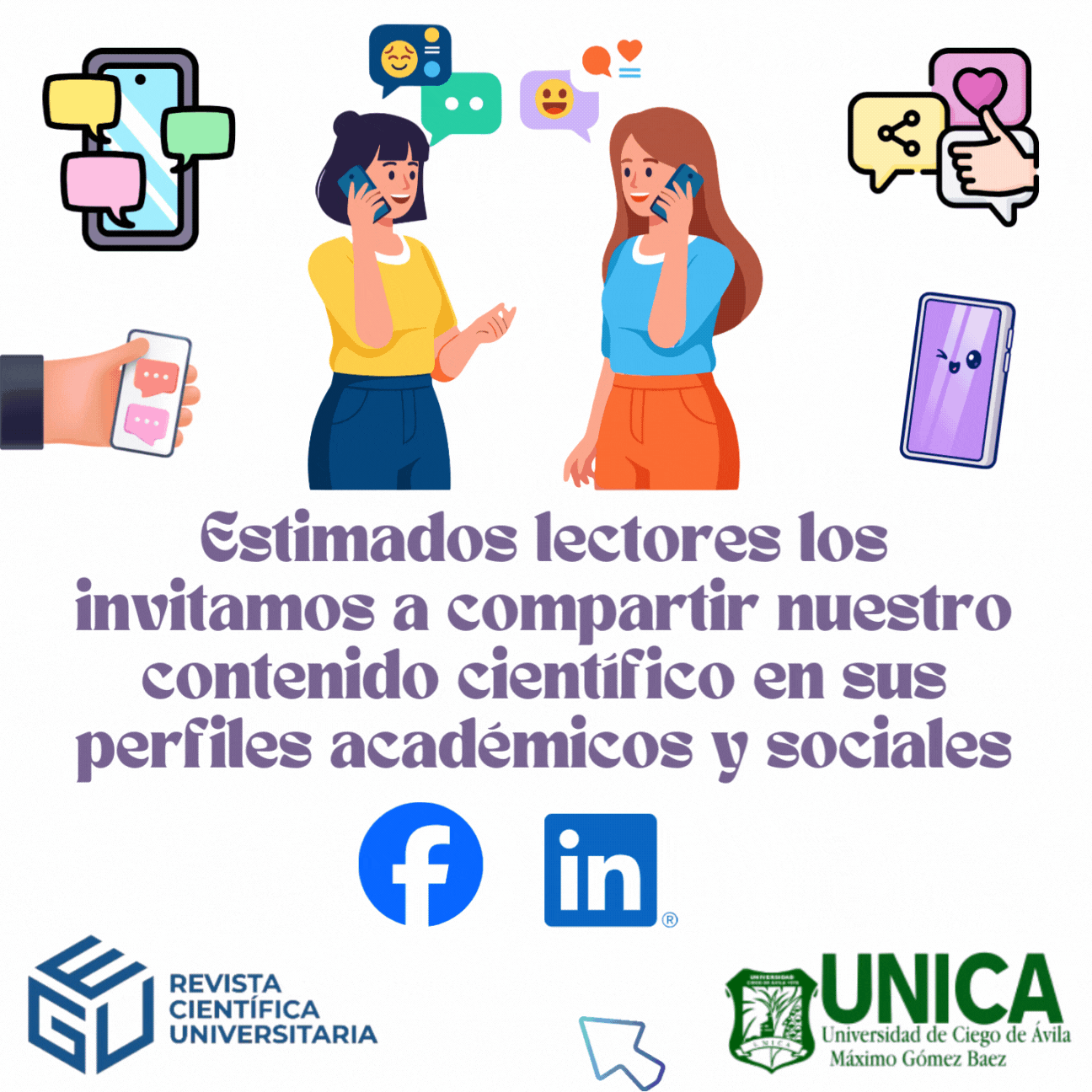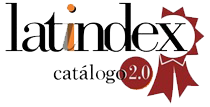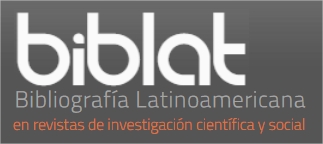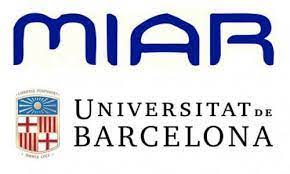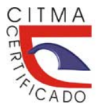Analysis of external communication disclosed on the social networks of the Technical University of Babahoyo
DOI:
https://doi.org/10.5281/zenodo.12594521%20Keywords:
external communication, social networks, university communication, Facebook, InstagramAbstract
Introduction: this study focuses on organizational communication, which has an incipient development in Ecuador and especially in the institutions of the Higher Education System. Objective: to analyze the external communication disclosed on the social networks of the Technical University of Babahoyo. Method: since this is a unique study, the case study method of a particular HEI was applied, from which three digital channels were selected: website and social networks: Facebook and Instagram of the UTB. By using the content analysis technique, these were monitored during an established period of time. Results: the periodicity of the communication flow of the social network Facebook, the interactions and the feedback that occurs among users, are determined. Conclusion: in this sense it is evident that the flow of communication on Instagram is minimal; and the management of the website by the institution.
Downloads
References
Aguirre, S., & Chiquito, B. (2019). Auditoría de Imagen de Radio Cre Satelital en la Ciudad de Guayaquil. En N. A. González Rodríguez y A. M. Colina Vargas (Eds.), La identidad e imagen corporativa en las instituciones de educación superior. Caso Universidad ECOTEC.
Allen, K. A., Gray, D. L., Baumeister, R. F., & Leary, M. R. (2022). The need to belong: A deep dive into the origins, implications, and future of a foundational construct. Educational psychology review, 34(2), 1133-1156. https://doi.org/10.1007/s10648-021-09633-6
Alvarado, M. G., González, J. S., & Cabezuelo-Lorenzo, F. (2022). La comunicación interna como herramienta estratégica constructora y transmisora de la cultura organizacional. aDResearch: Revista Internacional de Investigación en Comunicación, (27), 54-69. https://dialnet.unirioja.es/servlet/articulo?codigo=8340667
Ariza, F. J., & Ariza, J. M. (2021). Comunicación empresarial y atención al cliente. McGraw-Hill Interamericana.
Barón, B., García, D., Guativa, J., & Cancino, J. (2011). La comunicación verbal en la escuela: más allá de las palabras. Una muestra de la actividad desarrollada por maestros formados en investigación. Actualidades Pedagógicas, 1(57), 87-118. https://ciencia.lasalle.edu.co/ap/vol1/iss57/13/
Barragán Martínez, X. (2022). Posmodernidad, gestión pública y tecnologías de la información y comunicación en la Administración pública de Ecuador. Estado & comunes, revista de políticas y problemas públicos, 1(14), 113-131. https://doi.org/10.37228/estado_comunes.v1.n14.2022.244
Cheng, K., Cai, N., Zhu, J., Yang, X., Liang, H., & Zhang, W. (2022). Tumor‐associated macrophages in liver cancer: from mechanisms to therapy. Cancer Communications, 42(11), 1112-1140. https://doi.org/10.1002/cac2.12345
Cóndor, L. (2018). Páginas web educativas. [Monografía de pregrado, Universidad Nacional de Educación]. https://acortar.link/tlwedS
del-Castillo-Feito, C., Blanco-González, A., & Hernández-Perlines, F. (2022). The impacts of socially responsible human resources management on organizational legitimacy. Technological Forecasting and Social Change, 174, 121274. https://doi.org/10.1016/j.techfore.2021.121274
Díaz-Chieng, L. Y., Auza-Santiváñez, J. C., & Robaina Castillo, J. I. (2022). The future of health in the metaverse. Metaverse Basic and Applied Research, 1, 1. https://doi.org/10.56294/mr20221
Fernández Collado, C. (2009). La comunicación en las organizaciones (Trillas, Ed.; 2da Ed.). Trillas. https://acortar.link/EH3xp6
Fernández Cueria, N., Pérez Ricardo, E. D. C., Medina Labrada, J. R., Coronado Provance, K. Z., & Feria Velázquez, F. F. (2022). Gestión del marketing digital en organizaciones turísticas. Visión de futuro, 26(2), 188-210. www.scielo.org.ar/scielo.php?pid=S1668-87082022000200188&script=sci_arttext
Gómez Cano, C. A., & Sánchez Castillo, V. (2023). Systematic review on Augmented Reality in health education. Gamification and Augmented Reality, 1, 28. https://doi.org/10.56294/gr202328
Gonzales, Y. M., Napoleón, L., y Pérez, A. J. (2023). Metaverso y educación: un espacio complejo para la próxima revolución educacional. Metaverse Basic and Applied Research, 2 (56), 1-10. https://doi.org/10.56294/mr202356
Guerra, D. D. D., Gamboa, A. J. P., & Cano, C. A. G. (2023). Social network analysis in virtual educational environments: Implications for collaborative learning and academic community development. AWARI, 4, 1–12. https://doi.org/10.47909/awari.595
Hernández, R., Collado, C., & Lucio, P. (2010). Metodología de la investigación. McGraw-Hill Interamericana.
Lee, Y. (2022). Dynamics of symmetrical communication within organizations: The impacts of channel usage of CEO, managers, and peers. International Journal of Business Communication, 59(1), 3-21. https://doi.org/10.1177/2329488418803661
León, P., & Trelles, C. (2019). Diagnóstico de comunicación e imagen en una Institución de Educación Superior. En N. A. González Rodríguez y A. M. Colina Vargas (Eds.), La identidad e imagen corporativa en las instituciones de educación superior. Caso Universidad ECOTEC.
Margaix-Arnal, D. (2008). Las bibliotecas universitarias y Facebook: cómo y por qué estar presentes. El Profesional de La Información, 17(6), 589–601. https://doi.org/10.3145/epi.2008.nov.02
Medina, R. (septiembre, 2022). Estadísticas de la situación Digital en Ecuador 2021-2022. Branch. https://acortar.link/ccRtcp
Morazán, F. (2019). Manual de estrategias didácticas para el aprendizaje de la comunicación educativa. McGraw-Hill Interamericana.
Munch, L., & Hernández, A. (2020). Comunicación oral y escrita. Cengage.
Ocampo Ramos, B. A. (2018). Análisis de contenido: un ejercicio explicativo. In Análisis de contenido: un ejercicio explicativo (pp. 148–167).
Ocaña, P., & Freire, T. (2022). Impacto de la gestión de redes sociales en las empresas gastronómicas. Revista Chakiñan de Ciencias Sociales y Humanidades, (16), 52-67. https://doi.org/10.37135/chk.002.16.03
Parillo, P., & Troncoso, M. (2019). Influencia de la red social instagram en la percepción de la imagen corporal en adolescentes. [Tesis, Universidad Católica de San Pablo]. http://repositorio.ucsp.edu.pe/bitstream/20.500.12590/16518/4/PARILLO_PEREZ_PAM_RED.pdf
Peña Bañuelos, O. M., Felix Colado, B. E., Qui Orozco, S. O., & Lavin Zatarain, S. (2019). El uso de redes sociales por universidades para la divulgación de información institucional. Revista Digital De Tecnologías Informáticas Y Sistemas, 2(1). https://www.redtis.org/index.php/Redtis/article/view/24
Pérez Gamboa, A. J., Gómez Cano, C. A., & Sánchez Castillo, V. (2022). Decision making in university contexts based on knowledge management systems. Data and Metadata, 1, 92. https://doi.org/10.56294/dm202292
Pianese, T., Errichiello, L., & da Cunha, J. V. (2023). Organizational control in the context of remote working: A synthesis of empirical findings and a research agenda. European Management Review, 20(2), 326-345. https://doi.org/10.1111/emre.12515
Puyt, R. W., Lie, F. B., & Wilderom, C. P. (2023). The origins of SWOT analysis. Long Range Planning, 56(3), 102304. https://doi.org/10.1016/j.lrp.2023.102304
Roman Acosta, D. D. (2023). Más allá de las palabras: inteligencia artificial en la escritura académica. Escritura Creativa, 4(2). https://ojs.nfshost.com/index.php/escritura_creativa/article/view/44
Roman-Acosta, D., & Barón Velandia, B. (2023). Del conocimiento individual a la sinergia colectiva: potenciando la colaboración en las redes de investigación. Estrategia y Gestión Universitaria, 11 (2), 221-251. https://doi.org/10.5281/zenodo.10085278
Sarell, J. J. (2022). Acercamiento a la historia de la evolución de la tecnología educativa en Venezuela. Areté, Revista Digital del Doctorado en Educación, 8(16), 75-98. https://doi.org/10.55560/arete.2022.16.8.4
Soto, E., & Escribano, E. (2019). El método estudio de caso y su significado en la investigación educativa. Red de Investigadores Educativos Chihuahua A.C., 203-229. file:///C:/Users/HP/Downloads/Dialnet-ElMetodoEstudioDeCasoYSuSignificadoEnLaInvestigaci-7042305.pdf
Souto, A. B. F., Rivera, I. P., & Araújo, J. R. (2023). Gabinetes de comunicación de las federaciones deportivas españolas: estructura, prácticas y afección del COVID-19. Retos: nuevas tendencias en educación física, deporte y recreación, (49), 993-1003. https://dialnet.unirioja.es/servlet/articulo?codigo=8996507
Urquiza, L., & Duarte, M. (2023). La Comunicación externa de la Universidad Técnica de Babahoyo. [Tesis de maestría, T-UCSG-POS-MPGC-34].
Vallejo, P. (2019). La comunicación institucional en los Hoteles de Sevilla: Análisis de la presencia y actividad en las redes sociales, Facebook, Twitter, Instagram y YouTube. [Tesis de Maestría, Universidad de Sevilla]. Repositorio Institucional. https://acortar.link/HuD6Ln
Vatter, J., Mayer, R., & Jacobsen, H. A. (2023). The evolution of distributed systems for graph neural networks and their origin in graph processing and deep learning: A survey. ACM Computing Surveys, 56(1), 1-37. https://doi.org/10.1145/359742
Vivar, J. C. (2017). Cultura jurídica en los públicos de interés de la Universidad Católica de Santiago de Guayaquil: La Facultad de Especialidades Empresariales. En M. G. Valdés (Ed.), Comunicación, cultura organizacional y responsabilidad social universitaria. Dirección de publicaciones de la UCSG.
Downloads
Published
How to Cite
Issue
Section
License
Copyright (c) 2024 Estrategia y Gestión Universitaria

This work is licensed under a Creative Commons Attribution-NonCommercial-ShareAlike 4.0 International License.



